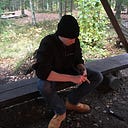Drawing with AI & Your Webcam
Turn Your Webcam into a Canvas Using MediaPipe Hands
Today, we’re going to explore how to draw on our webcam using MediaPipe Hands. This tutorial will guide you through using MediaPipe Hands in a fun and interactive way!
Let’s jump right into it!
First, ensure you have all the necessary packages. If not, run pip install mediapipe and pip install opencv-python to get started.
Next, we import the required packages into your Python script as follows:
import cv2
import mediapipe as mp
import numpy as npInitialize the MediaPipe Hands module for hand tracking:
# Initialize MediaPipe Hands module
mp_hands = mp.solutions.hands
hands = mp_hands.Hands(static_image_mode=False, max_num_hands=1)Set up your drawing preferences like pen size and color:
# Drawing configuration
PEN_SIZE = 5
COLORS = {"RED": (0, 0, 255)}
COLOR = COLORS["RED"]Now, let’s set up the main loop to manage webcam input, detect hand landmarks, and draw:
# Initialize the list to store points for drawing
drawing_points = []
# Setup video capture from webcam
video_capture = cv2.VideoCapture(0)
# Create a persistent image to draw on
success, frame = video_capture.read()
persistent_image = np.zeros_like(frame) if success else None
while True:
success, frame = video_capture.read()
if not success:
break # Exit loop if video capture failed
# Flip frame for a mirror effect and convert color to RGB
frame = cv2.flip(frame, 1)
rgb_frame = cv2.cvtColor(frame, cv2.COLOR_BGR2RGB)
# Process the RGB image
results = hands.process(rgb_frame)
# Work on a copy of the persistent image
image_for_drawing = persistent_image.copy()
if results.multi_hand_landmarks:
draw_on_image(image_for_drawing, results)
# Overlay the drawing image on the current frame
combined_image = cv2.addWeighted(frame, 0.5, image_for_drawing, 0.5, 0)
# Display the combined image
cv2.imshow("Drawing", combined_image)
if cv2.waitKey(1) & 0xFF == ord("q"):
break
# Update the persistent image with the new drawing
persistent_image = image_for_drawing.copy()
# Release video capture and destroy all OpenCV windows
video_capture.release()
cv2.destroyAllWindows()Next, we need to define the draw_on_image() function, which lets us draw using hand landmarks:
def draw_on_image(image, result, finger_index=8):
"""Draw on image based on hand landmarks at finger index."""
if result.multi_hand_landmarks:
for hand_landmarks in result.multi_hand_landmarks:
height, width, _ = image.shape
# Get the finger position
finger_pos = hand_landmarks.landmark[finger_index]
finger_x, finger_y = int(finger_pos.x * width), int(finger_pos.y * height)
# Add the point
drawing_points.append((finger_x, finger_y))
# Draw lines between points
if len(drawing_points) > 1:
for i in range(1, len(drawing_points)):
cv2.line(
image,
drawing_points[i - 1],
drawing_points[i],
COLOR,
PEN_SIZE,
)With that, you can run your project and see the magic happen!
$ python machine_learning/webcam_hand_draw.pyIt looks really cool! 😎
Challenges
- Introduce a feature that gradually fades your drawings over time.
- Use both hands; draw with one hand while erasing with the other.
- Improving the drawing smoothness.
I look forward to seeing your take on these challenges. Share your progress! Also, if you’re interested in seeing these features developed in an upcoming tutorial, let me know!
Full code
Here’s the full code:
"""Webcam hand draw."""
# pylint: disable=no-member
from typing import Any
import cv2
import mediapipe as mp
import numpy as np
from cv2.typing import MatLike
# Initialize MediaPipe Hands module for hand tracking
mp_hands = mp.solutions.hands
hands = mp_hands.Hands(static_image_mode=False, max_num_hands=1)
# Drawing configuration
PEN_SIZE = 5
COLORS = {"RED": (0, 0, 255)}
COLOR = COLORS["RED"]
def draw_on_image(image: MatLike, result: Any, finger_index: int = 8) -> None:
"""Draw on image based on hand landmarks at finger index.
:param image: The image to draw on.
:param result: The detected hand landmarks from MediaPipe.
:param finger_index: The index of the finger tip to use for drawing.
"""
if result.multi_hand_landmarks:
for hand_landmarks in result.multi_hand_landmarks:
height, width, _ = image.shape
# Get the finger position
finger_pos = hand_landmarks.landmark[finger_index]
finger_x, finger_y = int(finger_pos.x * width), int(
finger_pos.y * height
)
# Add the point
drawing_points.append((finger_x, finger_y))
# Draw lines between points
if len(drawing_points) > 1:
for i in range(1, len(drawing_points)):
cv2.line(
image,
drawing_points[i - 1],
drawing_points[i],
COLOR,
PEN_SIZE,
)
# Initialize the list to store points for drawing
drawing_points = []
# Setup video capture from webcam
video_capture = cv2.VideoCapture(0)
# Create a persistent image to draw on
success, frame = video_capture.read()
persistent_image = np.zeros_like(frame) if success else None
while True:
success, frame = video_capture.read()
if not success:
break # Exit loop if video capture failed
# Flip frame for a mirror effect and convert color to RGB
frame = cv2.flip(frame, 1)
rgb_frame = cv2.cvtColor(frame, cv2.COLOR_BGR2RGB)
# Process the RGB image
results = hands.process(rgb_frame)
# Work on a copy of the persistent image
image_for_drawing = persistent_image.copy()
if results.multi_hand_landmarks:
draw_on_image(image_for_drawing, results)
# Overlay the drawing image on the current frame
combined_image = cv2.addWeighted(frame, 0.5, image_for_drawing, 0.5, 0)
# Display the combined image
cv2.imshow("Drawing", combined_image)
if cv2.waitKey(1) & 0xFF == ord("q"):
break # Exit loop if 'q' is pressed
# Update the persistent image with the new drawing
persistent_image = image_for_drawing.copy()
# Release video capture and destroy all OpenCV windows
video_capture.release()
cv2.destroyAllWindows()Further Reading
If you want to learn more about programming and, specifically, machine learning, see the following course:
Note: If you use my links to order, I’ll get a small kickback. So, if you’re inclined to order anything, feel free to click above.
Links
- MediaPipe Documentation: MediaPipe
- OpenCV Python Package: PyPI OpenCV
- MediaPipe Package: PyPI MediaPipe
- Complete Code on GitHub: webcam_hand_draw.py

